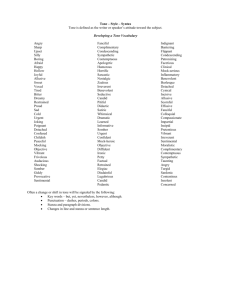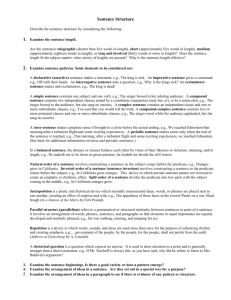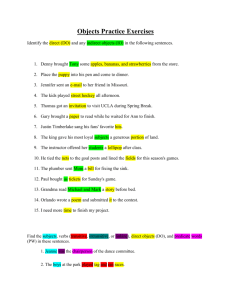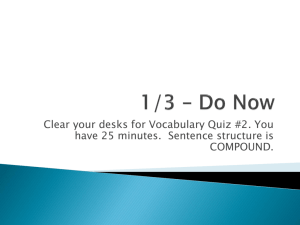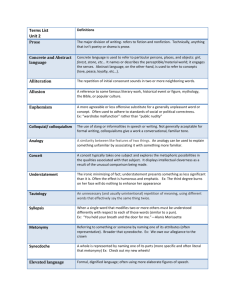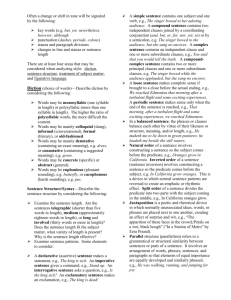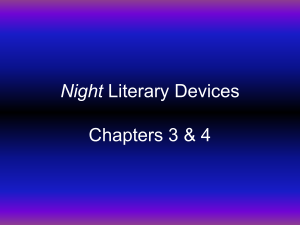File - AP English IV
advertisement
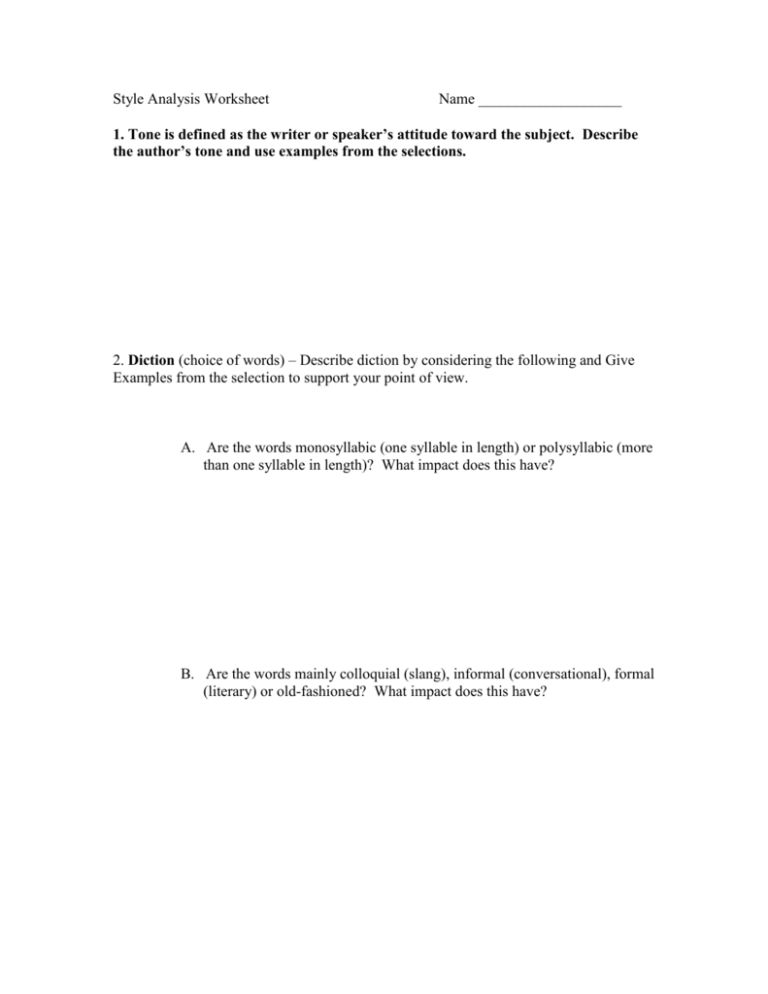
Style Analysis Worksheet Name ___________________ 1. Tone is defined as the writer or speaker’s attitude toward the subject. Describe the author’s tone and use examples from the selections. 2. Diction (choice of words) – Describe diction by considering the following and Give Examples from the selection to support your point of view. A. Are the words monosyllabic (one syllable in length) or polysyllabic (more than one syllable in length)? What impact does this have? B. Are the words mainly colloquial (slang), informal (conversational), formal (literary) or old-fashioned? What impact does this have? C. Are the words mainly denotative (containing an exact meaning), e.g. dress, or connotative (containing a suggested meaning), e.g. gown. What impact does this have? D. Are the words concrete (specific) or abstract (general)? What impact does this have? E. Are the words may be euphonious (pleasant sounding)or cacophonous (harsh sounding) What impact does this have? 2. Sentence Structure – Describe the author’s sentence structure by considering the following: a. Examine the sentence length. Are the sentences telegraphic (shorter than 5 words in length), medium (approximately eighteen words in length), or long and involved (thirty words or more in length)? Does the sentence length fit the subject matter, what variety of lengths is present? Why is the sentence length effective? b. Examine sentence patterns. Some elements to consider are listed below: i. A declarative sentence (assertive) makes a statement, simple sentence contains one subject and one verb, A compound sentence contains two independent clauses joined by a coordinate conjunction (and, but, or) or by a semicolon, A complex sentence contains an independent clause and one or more subordinate clauses,. A compound-complex sentence contains two or more principal clauses and one or more subordinate clause What is the main sentence pattern employed by the author? Give examples and support the impact that this has. ii. A loose sentence makes complete sense if brought to a close before the actual ending, e.g. We reached Edmonton that morning after a turbulent fight and some exciting experiences. A periodic sentence makes sense only when the end of the sentence is reached, e.g., That morning, after a turbulent flight and some exciting experiences, we reached Edmonton. Are the sentences loose or periodic? Give examples and support the impact that this has. iii.Natural order of a sentence involves constructing sentences so the subject comes before the predicate, e.g., Oranges grow in California. Inverted order of a sentence (sentence inversion) involves constructing sentences so the predicate comes before the subject, e.g., In California grow oranges. This is a device in which normal sentence patterns are reversed to create an emphatic or rhythmic effect. Split order of sentences divides the predicate into two parts with the subject coming in the middle, e.g., In California oranges grow. What order do the sentences mainly have? Give examples and support the impact that this has. c. Examine sentence beginnings. Is there good variety or does a pattern emerge? d. Examine the arrangement of ideas in a sentence. Are they set out in a special way for a purpose? e. Examine the arrangement of ideas in a paragraph to see if there is any evidence of any patterns or structure. f. Using the notes on figures of speech, what schemes of hyperbaton does the author use? What impact do these have? g. Using the notes on figures of speech, what schemes of balance does the author use? What impact do these have? h. Using the notes on figures of speech, what schemes of repetition does the author use? What impact do these have 3. Treatment of Subject Matter – Describe the author’s treatment of subject matter by considering the following: (NON-FICTION) a. Is the author Subjective? Are conclusions based upon opinions; are they rather personal in nature? Give Examples and explain the impact that this has. b. Is the author objective? Are conclusions based upon facts; are they impersonal or scientific? c. (this is used for non-fiction essays) Is the author supportive of the main idea? If so, how were the claims supported? Did he: a. state his opinions, b. report his experiences, c. report observations, d. refer to readings, e. refer to statements made by experts, f. use statistical data? 4. Tropes a. Did the author use simile? Give examples and explain the impact that these had. b. Did the author use metaphor? Give examples and explain the impact that these had. c. Did the author use personificatio? Give examples and explain the impact that these had. d. Did the author use hyperbole? (Hyperbole is a deliberate, extravagant and often outrageous exaggeration) Give examples and explain the impact that these had. e. Did the author use Meiosis? (Meiosis is the opposite of hyperbole. It is a kind of irony which deliberately represents something as much less than it really is is a deliberate, extravagant and often outrageous exaggeration) Give examples and explain the impact that these had. f. Did the author use oxymoron? (Oxymoron is a form of paradox which combines a pair of contrary terms into a single expression) Give examples and explain the impact that these had. g. Did the author use irony? Give examples and explain the impact that this had h. Did the author use Apostrophe? (a form of personification in which the absent or dead are spoken to as if present, and the inanimate as if animate. Those are all addressed directly). Give examples and explain the impact that this had i. Did the author use Allusion (a reference to a mythological, literary, historical, or Biblical person, place or thing) Give examples and explain the impact that this had j. Did the author use Synecdoche? (synecdoche, a part of something is used to signify the whole), e.g., All hands on deck. Also the reverse, whereby the whole can represent a part is synecdoche, e.g., Canada played the United States in the Olympic hockey finals. Another form of synecdoche involves the container representing the thing being contained, e.g., The pot is boiling. One last form of synecdoche involves the material from which an object is made standing for the object itself, e.g., The quarterback tossed the pigskin. Give examples and explain the impact that this had K Did the author use metonymy? (Metonymy is the name of one thing is applied to another thing with which it is closely associated,) Give examples and explain the impact that this had
